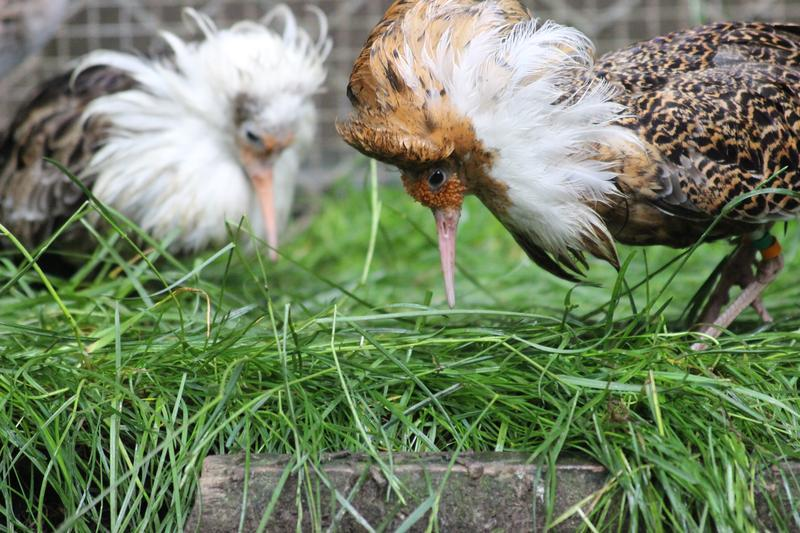Super Enzyme Helps Regulate Testosterone in Male Birds
Super Enzyme Helps Regulate Testosterone in Male Birds
There are three types of male ruffs, known as morphs, that differ with regard to their appearance and behavior. “Independents,” which account for the vast majority, have darker plumage and aggressively defend a small territory in mating arenas called leks to impress females. The slightly smaller “satellites” have lighter-colored plumage and court peacefully, occasionally being tolerated in independents’ territories as their presence helps to attract more females. The rarer “faeder” morphs take a stealthier approach: they have plumage that is hard to distinguish from female ruffs, allowing them to sneak into the mating arenas unnoticed. Earlier studies have shown that the more aggressive, territory defending independents have higher levels of testosterone in their blood, while this is not the case for the more peaceable satellites and faeders.
However, when the team behind this latest study measured the testosterone levels in ruffs’ testes, they found that faeders and satellites actually produced far more testosterone in their testes than the independents. This begged the question of how these two morphs could have such low testosterone levels in their blood while having such high levels in the testes. The answer presented itself in the form of a “super enzyme.” The researchers discovered that the three morphs only differ from one another in a single DNA region (or “supergene”) comprising roughly one hundred genes. “This region originated around four million years ago when a chromosome fragment broke out and then reinserted itself in the opposite direction,” says Katja Nowick, professor of human biology at Freie Universität Berlin. When they performed gene expression analyses, the researchers noticed a specific gene within this supergene that coded for an enzyme that breaks down testosterone. This enzyme was being produced in large quantities in faeders and satellites – but not at all in the independents. Particularly of interest was the fact that this enzyme was not present in the testes, where testosterone is produced. Rather, it was present in large quantities in the blood and brains of satellites and faeders, allowing them to maintain generally low levels of testosterone.
Testosterone not only regulates the production of sperm, it also influences aggressiveness and courtship behavior. The ability to break down and regulate testosterone could be related to the birds’ mating strategies. “The study demonstrates how a single gene can have far-reaching effects and play an important role in the evolution of complex behavioral strategies,” says Vladimir Jovanović, a postdoctoral researcher in Nowick’s working group. Going forward, the team wants to look more closely at how complex social behaviors are regulated in ruffs and continue exploring the diversity within the sexes.Testosterone regulation
Male birds
Super enzyme
Hormonal control
Bird physiology
Enzyme function
Endocrine system
Reproductive hormones
Avian biology
Steroidogenesis
Testosterone metabolism
Enzymatic activity
Hormonal balance
Avian reproduction
Male hormone regulation
#TestosteroneRegulation
#BirdsOfScience
#AvianBiology
#EnzymeResearch
#HormonalControl
#MaleBirds
#WildlifeScience
#AnimalPhysiology
#Endocrinology
#Ornithology
#ScientificDiscovery
#EnzymeFunction
#Testosterone
#BirdBehavior
#NatureResearch
#HormoneRegulation
#AvianStudies
#WildlifeBiology
#Ecophysiology
#BiologyBreakthroughs
#BirdsOfScience
#AvianBiology
#EnzymeResearch
#HormonalControl
#MaleBirds
#WildlifeScience
#AnimalPhysiology
#Endocrinology
#Ornithology
#ScientificDiscovery
#EnzymeFunction
#Testosterone
#BirdBehavior
#NatureResearch
#HormoneRegulation
#AvianStudies
#WildlifeBiology
#Ecophysiology
#BiologyBreakthroughs
Award Nomination Link - https://germanscientist.com/award-nomination/?ecategory=Awards&rcategory=Awardee
Member Nomination Link - https://germanscientist.com/member-submission/?ecategory=Membership&rcategory=Member
Award Registration Link - https://germanscientist.com/award-registration/
Member Registration Link - https://germanscientist.com/member-registration/
For Enquiries: contact@germanscientist.com
Get Connected Here
--------------------------------
--------------------------------




Comments
Post a Comment